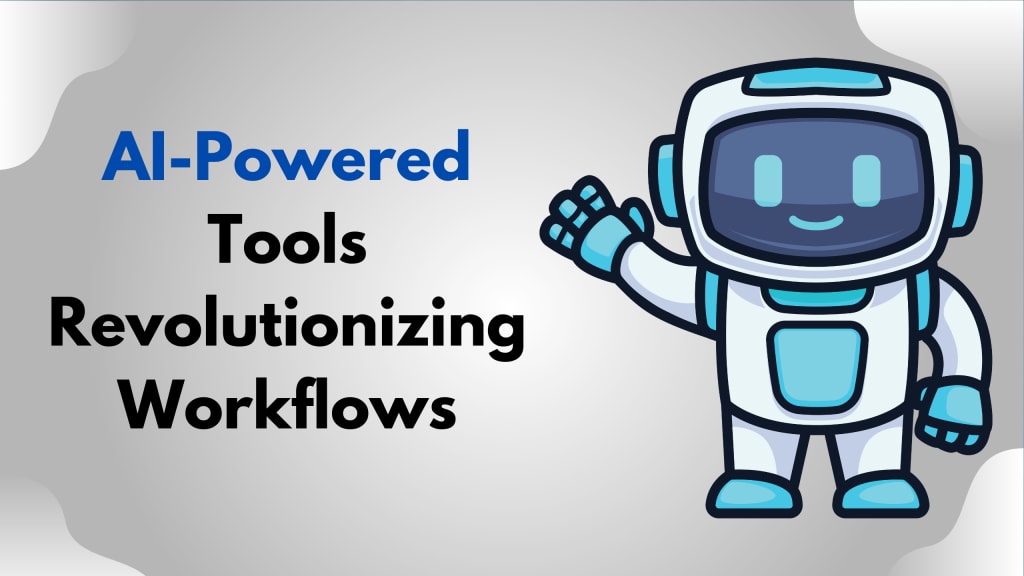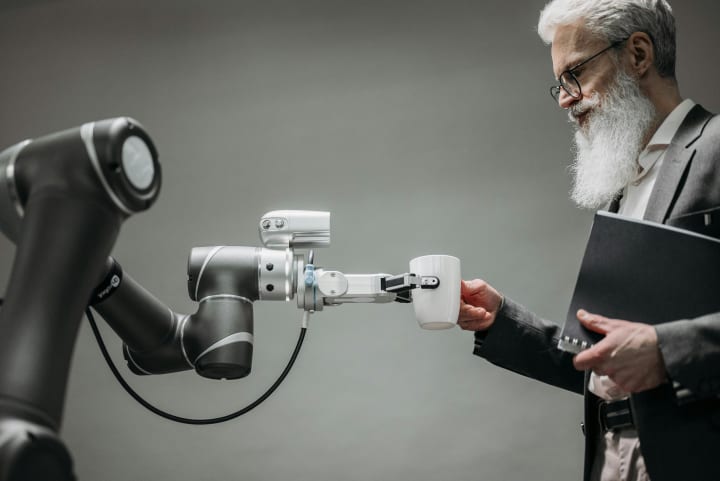AI-Powered Tools Revolutionizing Workflows
Transforming Productivity and Innovation Across Industries

Introduction
Artificial Intelligence (AI) has made remarkable strides over the past decade, permeating various industries and transforming the way we work. In 2024, AI-powered tools are at the forefront of this revolution, enhancing productivity, efficiency, and innovation. This article delves into how these tools are revolutionizing workflows across different sectors, the benefits they bring, and the challenges they pose.
AI in Programming: The Rise of AI Code Assistants
One of the most significant impacts of AI is seen in the field of programming. AI code assistants, such as GitHub Copilot, Codeium, and Tabnine, are transforming how developers write and manage code. These tools leverage large language models and machine learning algorithms to suggest code snippets, identify and fix errors, and even generate entire blocks of code from natural language descriptions.

Benefits:
Increased Productivity: AI code assistants help developers write code faster by providing instant suggestions and automating repetitive tasks.
Error Reduction: These tools can identify potential bugs and errors in real-time, significantly reducing the time spent on debugging.
Learning Aid: For novice programmers, AI code assistants serve as an educational tool, offering guidance and best practices.
Challenges:
Dependence on AI: Over-reliance on AI tools may hinder the development of fundamental coding skills.
Security Concerns: AI-generated code could introduce vulnerabilities if not carefully reviewed.
AI in Content Creation: Revolutionizing Writing and Media Production
AI-powered writing tools are changing the landscape of content creation. Tools like OpenAI's ChatGPT, Jasper, and Copy.ai are capable of generating high-quality written content, from blog posts to marketing copy, in a fraction of the time it would take a human writer.
Benefits:
Efficiency: AI writing tools can produce large volumes of content quickly, which is particularly useful for businesses that need to maintain a high output.
Consistency: These tools ensure consistency in tone and style, which is essential for brand messaging.
Cost-Effectiveness: By automating content creation, companies can reduce their reliance on human writers and lower costs.

Challenges:
Quality Control: While AI tools can generate coherent content, they may lack the nuance and creativity of human writers. Editorial oversight is still necessary.
Ethical Concerns: The use of AI in content creation raises questions about authorship and originality.
AI in Design: Enhancing Creativity and Precision
AI-powered design tools are revolutionizing the creative industry by offering advanced features for graphic design, video editing, and animation. Tools like Adobe Sensei and Canvas AI-powered design assistants enable designers to create stunning visuals with greater efficiency and precision.

Benefits:
Creative Assistance: AI tools can suggest design elements, color schemes, and layouts, enhancing the creative process.
Time-Saving: Automation of repetitive tasks, such as background removal and image enhancement, allows designers to focus on more complex aspects of their work.
Accessibility: AI-powered design tools make professional-grade design accessible to non-designers.
Challenges:
Over-Reliance on AI: Excessive dependence on AI tools could stifle human creativity.
Job Displacement: As AI takes over more design tasks, there may be concerns about job displacement in the creative industry.

AI in Customer Service: Transforming Customer Interactions
AI-powered chatbots and virtual assistants are transforming customer service by providing instant, around-the-clock support. Tools like Zendesk's Answer Bot and IBM's Watson Assistant are capable of handling a wide range of customer inquiries, from simple FAQs to complex troubleshooting.
Benefits:
24/7 Availability: AI chatbots can provide support at any time, improving customer satisfaction.
Scalability: These tools can handle multiple inquiries simultaneously, making them ideal for businesses with high customer interaction volumes.
Data Insights: AI tools can analyze customer interactions to provide valuable insights into customer behavior and preferences.
Challenges:
Lack of Human Touch: While AI can handle many tasks, it may lack the empathy and personal touch of human customer service representatives.
Complex Queries: AI may struggle with handling highly complex or nuanced inquiries, requiring human intervention.
AI in Project Management: Streamlining Operations
AI-powered project management tools like Asana's Smart Assistant and Trello's Butler are revolutionizing how teams plan, execute, and track projects. These tools use AI to automate task assignments, predict project timelines, and provide actionable insights.
Benefits:
Efficiency: AI tools automate routine project management tasks, freeing up time for strategic activities.
Predictive Analytics: By analyzing past project data, AI can predict potential delays and resource bottlenecks, allowing for proactive management.
Collaboration: AI-powered tools enhance team collaboration by providing real-time updates and intelligent recommendations.
Challenges:
Integration: Integrating AI tools with existing project management systems can be challenging.
Dependence on Data: AI's effectiveness is heavily dependent on the quality and quantity of data available.

AI in Healthcare: Revolutionizing Patient Care
AI is making significant inroads in healthcare, with tools like IBM Watson Health and Google's DeepMind revolutionizing patient care. These tools can analyze medical data to assist in diagnosis, predict patient outcomes, and personalize treatment plans.
Benefits:
Accurate Diagnoses: AI tools can analyze vast amounts of medical data to identify patterns and assist in accurate diagnoses.
Personalized Treatment: By considering individual patient data, AI can recommend personalized treatment plans.
Efficiency: AI can automate administrative tasks, allowing healthcare professionals to focus on patient care.
Challenges:
Data Privacy: The use of AI in healthcare raises concerns about patient data privacy and security.
Trust: Patients and healthcare providers may be hesitant to trust AI-generated recommendations.

AI in Finance: Enhancing Decision-Making
AI-powered tools are transforming the finance industry by providing advanced analytics, fraud detection, and automated trading. Tools like AlphaSense and Kabbage use AI to analyze financial data, detect anomalies, and provide investment insights.
Benefits:
Risk Management: AI tools can analyze market data to identify risks and recommend mitigation strategies.
Fraud Detection: AI can detect fraudulent transactions in real time, reducing financial losses.
Investment Insights: AI can analyze vast amounts of financial data to provide valuable investment insights.
Challenges:
Regulatory Compliance: The use of AI in finance must comply with stringent regulatory requirements.
Bias: AI models can be biased if trained on biased data, leading to unfair or inaccurate decisions.

Best Practices for Integrating AI Tools
Ensure Data Quality:
Clean and Comprehensive Data: High-quality, well-structured data is critical for AI effectiveness. Organizations must invest in robust data management practices to ensure their data is accurate, complete, and up-to-date.
Regular Audits: Conduct regular audits of data sources and AI outputs to identify and correct biases or errors.
Maintain Human Oversight:
Human-in-the-Loop Systems: Implement systems where human judgment complements AI decision-making, ensuring critical oversight and preventing over-reliance on automated processes.
Training and Development: Continuously train employees on the capabilities and limitations of AI tools, fostering a collaborative environment where AI and human expertise work together.
Address Ethical Concerns:
Transparent Algorithms: Use transparent and explainable AI algorithms to foster trust and accountability. This helps in understanding how AI arrives at its decisions, making it easier to address any biases or inaccuracies.
Ethical Guidelines: Develop and adhere to ethical guidelines for AI use, ensuring respect for privacy, fairness, and non-discrimination.
Adapt to Regulatory Changes:
Stay Informed: Keep abreast of evolving regulatory landscapes concerning AI and data privacy. Ensure compliance with local and international regulations to avoid legal repercussions.
Proactive Adaptation: Be proactive in adapting AI systems to comply with new regulations, incorporating changes into workflows well in advance.

The Road Ahead: Innovations and Trends
Edge AI:
Decentralized Processing: Edge AI involves processing data locally on devices rather than relying on centralized cloud servers. This approach reduces latency, enhances data privacy, and enables real-time decision-making.
Applications: Edge AI is particularly useful in sectors like healthcare (real-time patient monitoring), manufacturing (predictive maintenance), and autonomous vehicles (instantaneous navigation decisions).
AI and Internet of Things (IoT):
Synergistic Integration: The convergence of AI and IoT is creating smarter, more responsive systems. AI enhances IoT devices by providing advanced analytics and automation capabilities.
Smart Homes and Cities: In smart homes, AI-powered IoT devices optimize energy consumption, enhance security, and improve convenience. Similarly, smart city initiatives leverage AI and IoT to manage resources efficiently, reduce congestion, and improve public services.
AI in Cybersecurity:
Proactive Defense: AI enhances cybersecurity by identifying and mitigating threats in real time. AI systems can analyze vast amounts of data to detect anomalies, predict potential attacks, and automate responses.
Adaptive Learning: AI cybersecurity tools continuously learn from new threats, adapting their defenses to stay ahead of cybercriminals.
AI for Personalized Experiences:
Customer Insights: AI tools analyze customer data to deliver personalized experiences, improving satisfaction and loyalty. This is evident in sectors like retail (personalized shopping recommendations) and entertainment (tailored content suggestions).
Healthcare Personalization: In healthcare, AI personalizes treatment plans based on individual patient data, improving outcomes and patient engagement.

Conclusion
AI-powered tools are undeniably revolutionizing workflows across various industries. They offer numerous benefits, including increased productivity, efficiency, and innovation. However, the adoption of these tools also brings challenges that need to be addressed, such as over-reliance on AI, ethical concerns, and data privacy issues. As we move forward, it is essential to strike a balance between leveraging AI's capabilities and maintaining human oversight to ensure these tools are used responsibly and effectively.
The integration of AI-powered tools into workflows is revolutionizing industries, driving unprecedented levels of productivity, efficiency, and innovation. While the benefits are substantial, it is crucial to navigate the associated challenges with a balanced approach that prioritizes data quality, ethical considerations, and human oversight.
As we look to the future, the continuous evolution of AI technologies will unlock new possibilities, from edge AI and IoT integration to advanced cybersecurity and personalized experiences. By embracing these innovations thoughtfully and responsibly, organizations can harness the full potential of AI to drive sustained success and transformation.
About the Creator
Raja Trends
Here, my friends get important updates and interesting stories to catch everything you will need. To get important article notifications and updates. Please Subscribe to Motivate me to Upload High-Quality content and articles.
Enjoyed the story? Support the Creator.
Subscribe for free to receive all their stories in your feed. You could also pledge your support or give them a one-off tip, letting them know you appreciate their work.






Comments
There are no comments for this story
Be the first to respond and start the conversation.